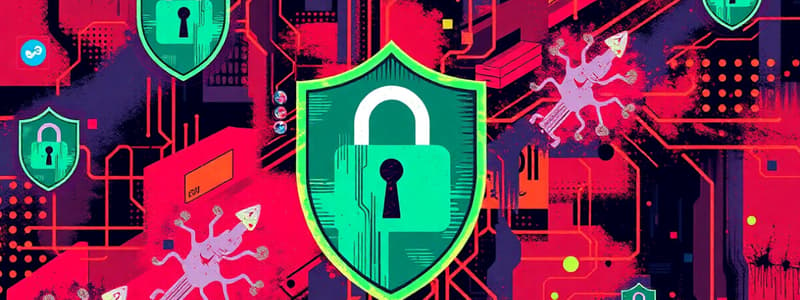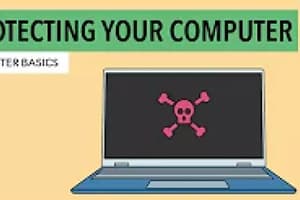Podcast
Questions and Answers
What is the primary method through which computer viruses replicate and spread?
What is the primary method through which computer viruses replicate and spread?
- By exploiting social engineering tactics in email communications
- By encrypting user files to launch a ransom demand
- By altering system settings to allow malicious downloads
- By inserting themselves into executable programs or scripts (correct)
What is a primary characteristic that distinguishes Trojans from computer viruses?
What is a primary characteristic that distinguishes Trojans from computer viruses?
- Trojans replicate independently without user intervention
- Trojans only exist as email attachments
- Trojans disguise themselves as legitimate programs (correct)
- Trojans are more easily detected by antivirus software
Which of the following statements about ransomware is accurate?
Which of the following statements about ransomware is accurate?
- All ransomware attacks are easy to fix
- Ransomware requires users to pay with credit cards only
- Ransomware may encrypt files and demand payment to restore access (correct)
- Ransomware exclusively targets only operating systems
What function do keyloggers serve as a type of spyware?
What function do keyloggers serve as a type of spyware?
What measure can help prevent malware infections when using removable media?
What measure can help prevent malware infections when using removable media?
What is the purpose of device hardening?
What is the purpose of device hardening?
Why is enabling passwords on devices important?
Why is enabling passwords on devices important?
Which of the following is a consequence of having default or weak passwords on network devices?
Which of the following is a consequence of having default or weak passwords on network devices?
What should be done with features, services, or protocols that are not being used on a device?
What should be done with features, services, or protocols that are not being used on a device?
What is meant by 'removing unwanted/unnecessary software' during device hardening?
What is meant by 'removing unwanted/unnecessary software' during device hardening?
What is the primary function of anti-virus software?
What is the primary function of anti-virus software?
What does 'on-access scanning' do?
What does 'on-access scanning' do?
Which of the following best describes a zero-day exploit?
Which of the following best describes a zero-day exploit?
What should be done first if a system is suspected to be infected with malware?
What should be done first if a system is suspected to be infected with malware?
Which action can anti-virus software NOT typically perform when it detects malware?
Which action can anti-virus software NOT typically perform when it detects malware?
What is a potential downside of real-time scanning in anti-virus software?
What is a potential downside of real-time scanning in anti-virus software?
Which of the following steps is NOT recommended to reduce malware infection risk?
Which of the following steps is NOT recommended to reduce malware infection risk?
Which function do heuristic techniques in anti-virus software serve?
Which function do heuristic techniques in anti-virus software serve?
What type of scanning inspects more file types than on-access scanning when run?
What type of scanning inspects more file types than on-access scanning when run?
Which of these is a critical feature of Windows Defender in Windows 10?
Which of these is a critical feature of Windows Defender in Windows 10?
Flashcards
Device Hardening
Device Hardening
A set of policies to secure mobile devices, workstations, and network appliances by implementing security measures.
Anti-virus/Anti-malware
Anti-virus/Anti-malware
Software that detects and prevents malicious software (malware) from running on a device.
Patching/Updates
Patching/Updates
Keeping operating systems, drivers, and firmware up-to-date to reduce vulnerabilities to malware.
Strong Passwords
Strong Passwords
Signup and view all the flashcards
Disabling Unused Features
Disabling Unused Features
Signup and view all the flashcards
Malware
Malware
Signup and view all the flashcards
Computer Virus
Computer Virus
Signup and view all the flashcards
Trojan
Trojan
Signup and view all the flashcards
Ransomware
Ransomware
Signup and view all the flashcards
Spyware
Spyware
Signup and view all the flashcards
Malware Infection Vector
Malware Infection Vector
Signup and view all the flashcards
Zero-Day Exploit
Zero-Day Exploit
Signup and view all the flashcards
Security Patch
Security Patch
Signup and view all the flashcards
Antivirus Software
Antivirus Software
Signup and view all the flashcards
On-Access Scanning
On-Access Scanning
Signup and view all the flashcards
Scheduled Scans
Scheduled Scans
Signup and view all the flashcards
Quarantine (malware)
Quarantine (malware)
Signup and view all the flashcards
Vulnerability
Vulnerability
Signup and view all the flashcards
Windows Defender
Windows Defender
Signup and view all the flashcards
Heuristic Identification
Heuristic Identification
Signup and view all the flashcards




